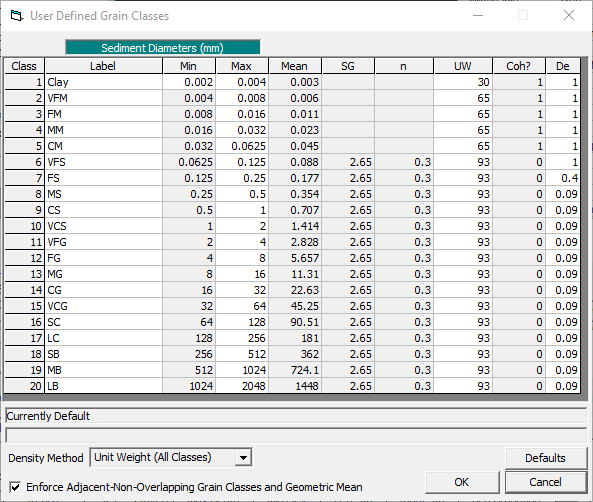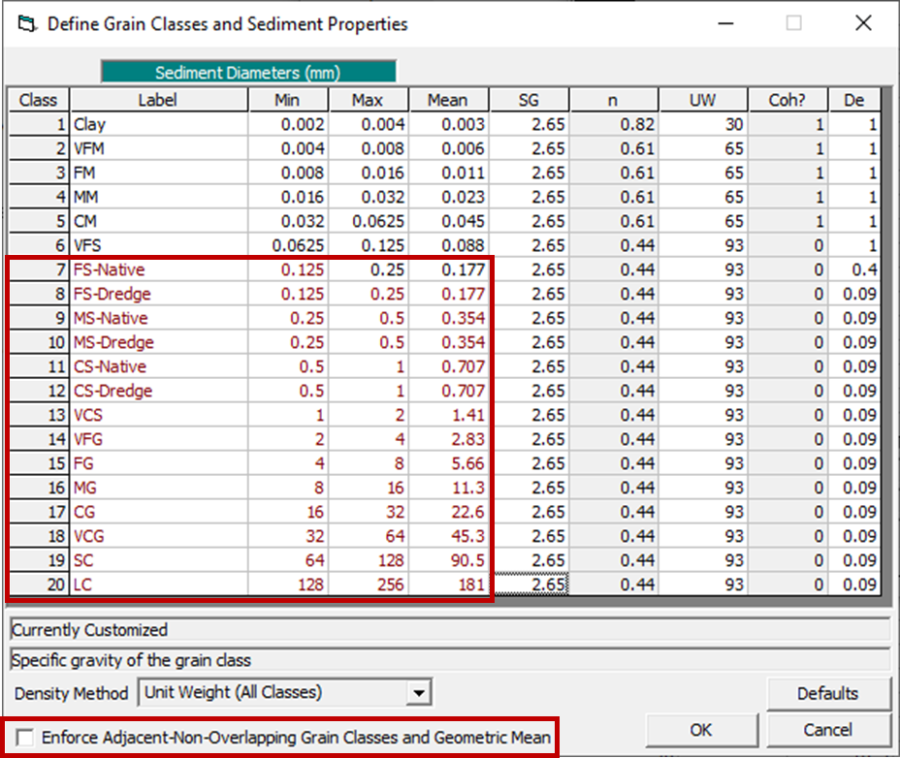Download PDF
Download page Define Grain Classes and Sediment Properties*.
Define Grain Classes and Sediment Properties*
Default and User Defined Grain Classes:
HEC-RAS defaults to twenty grain classes that follow the ψ scale (Parkers and Andrews, 1985) for which the grain class boundaries are defined by D=2ψ, where ψ includes the integers between -8 and 11. The default grain classes are detailed in the table below.
The user can define a customized set of grain classes in order to focus more detail in a particular size range or model specific grain sizes. Selecting the User Defined Grain Classes item on the Options menu allows the user to override default HEC-RAS grain classes. This menu option will open the dialog depicted in the figure below. The User Defined Grain Classes dialog defaults to the grain classes outlined in the table below, and will write a text line at the bottom of the dialog with a "Currently Default" message if this is the case (below).
HEC-RAS must have twenty grain classes, but it will only compute grain classes that exist in the model. HEC-RAS will ignore any grain classes that do not exist in the bed or the boundary conditions. Including fewer grain classes will speed up run times – particularly in the 2D sediment model.
Earlier versions of HEC-RAS required grain classes that are adjacent, increasing, and non-overlapping. Defining adjacent, increasing, non-overlapping grain classes is still usually best practice. Therefore, by default the lower bound of each grain class (except the first one) copies to the upper bound of the previous class. Users edit the grain classes in this mode by changing the upper bounds (labeled max in the figure below). The editor computes geometric For a good discussion of why it is appropriate to use the geometric mean of the lower bound and the upper bound as the representative grain class, see Dr Gary Parker's chapter on Graded Sediment Analysis in ASCE Manual 110 Sedimentation Engineering. means (which are the actual, representative grain size HEC-RAS uses in the computation) in the Mean. If the user changes the grain classes, the dialog will show the "Currently Customized" message in the panel below the buttons. Reset to the default parameters by pressing the Defaults button.
Default grain classes in HEC-RAS (mm).
Grain Classes | Lower | Upper | Mean | Geometric | |
Clay | Clay | 0.002 | 0.004 | 0.003 | 0.00283 |
Very Fine Silt | VFM | 0.004 | 0.008 | 0.006 | 0.00566 |
Fine Silt | FM | 0.008 | 0.016 | 0.011 | 0.0113 |
Medium Silt | MM | 0.016 | 0.032 | 0.023 | 0.0226 |
Coarse Silt | CM | 0.032 | 0.0625 | 0.045 | 0.0447 |
Very Fine Sand | VFS | 0.0625 | 0.125 | 0.088 | 0.0884 |
Fine Sand | FS | 0.125 | 0.25 | 0.177 | 0.177 |
Medium Sand | MS | 0.25 | 0.5 | 0.354 | 0.354 |
Coarse Sand | CS | 0.5 | 1 | 0.707 | 0.707 |
Very Course Sand | VCS | 1 | 2 | 1.41 | 1.41 |
Very Fine Gravel | VFG | 2 | 4 | 2.83 | 2.83 |
Fine Gravel | FG | 4 | 8 | 5.66 | 5.66 |
Medium Gravel | MG | 8 | 16 | 11.3 | 11.3 |
Coarse Gravel | CG | 16 | 32 | 22.6 | 22.6 |
Very Coarse Gravel | VCG | 32 | 64 | 45.3 | 45.3 |
Small Cobbles | SC | 64 | 128 | 90.5 | 90.5 |
Large Cobbles | LC | 128 | 256 | 181 | 181 |
Small Boulders | SB | 256 | 512 | 362 | 362 |
Medium Boulders | MB | 512 | 1024 | 724 | 724 |
Large Boulders | LB | 1024 | 2048 | 1448 | 1450 |

Current versions of HEC-RAS make the grain classes more flexible. Uncheck the Enforce Adjacent-Non-Overlapping Grain Classes and Geometric Mean box. This removes the interface control that enforces these constraints and allows users to edit the first four columns of this editor without limitation. In most cases, the adjacent, increasing, non-overlapping constraint is appropriate, and violating it can cause problems in the mixing algorithms (see Warning below). HEC-RAS also stops computing the geometric mean of the grain class if this feature is disengaged, so users will have to compute and enter their own representative grain class for edited grain classes. But this feature does allow users to generate duplicate grain classes of the same size class if they want to keep track of one of them.

Warning: Impact of Grain Class Order on Sorting Algorithms
The Thomas and Copeland sorting and mixing algorithms compute armoring based on the prevalence of coarser grain classes. These algorithms compute how much of each grain class the flow field has access to based on how much of the cover layer is composed of coarser particles. It identifies "coarser particles" as those particles in larger grain classes. Therefore, duplicate particles (or finer particles) in coarser (higher Class number) grain classes will artificially limit erosion in these algorithms. The representative grain size should never decrease as the grain class number increases.Warning: Limit the First Five Grain Classes to Fine Sediment Sizes
While grain classes are flexible the first five grain classes are considered 'cohesive' regardless of their size. The cohesive algorithms and parameters selected in the Cohesive Options will be applied to these grain classes. The Unit Weight and Densities in the Sediment Properties Editor tie unit weight to these grain classes. Additionally, mixing and armoring algorithms in both the main sediment model and BSTEM compute a "% cohesive" and take different approaches based on the percentage of the bed material in the first five grain classes. Therefore, when defining new grain classes, reserve the first five for materials that behave like cohesives and constrain cohesive materials (e.g. that will deposit and scour according to Krone and Partheniades methods) to these first five grain classes. (Note: Future versions will use the Coh? Column to control this behavior, but current and past versions assume these grain classes – and only these grain classes – are cohesive).
Specific Gravity, Porosity, and Unit Weight
Specific Gravity: The default specific gravity for all sediment particles is 2.65. While generally appropriate, this assumption is not universally valid. Users can change this value, but the current version of HEC-RAS only applies one specific gravity to all grain classes throughout the model. The grain class-specific specific gravity option is included for 2D sediment transport which has variable density algorithms.
Unit Weight/Density: Sediment unit weights or densities are used to convert deposited or eroded masses into volumes that translate into bed elevation changes. This is one of the only parameters that is different for SI and US customary units. US customary is defined in terms of unit weights (lb/ft3) while SI is defined in terms of density (kg/m3). HEC-RAS converts between density and unit weight internally. Clay (grain class 1), silt (grain classes 2-5) and sand/gravel (grain classes 6-20) each have distinct, default grain classes.
Modeling Note: Cohesive unit weight/density
Cohesive unit weight can vary substantially between systems and even within the same reservoir (e.g. deeper consolidated clays are often consolidated and much denser than surficial deposits). HEC-RAS adopted defaults from HEC 6 but are on the low end of the range, representing 'fluffy,' reservoir deposits. When calibrating a depositional cohesive model to volume change computed from repeated cross sections, cohesive density will be a very sensitive parameter. If you are over-predicting cohesive deposition, consider the applicability of this parameter.___________________________________________________
*This editor combines two different menus in version 5.0.7 and earlier. Because recent versions of HEC-RAS allow users to define sediment properties like density and unit weight by grain class, these properties are included in this editor.